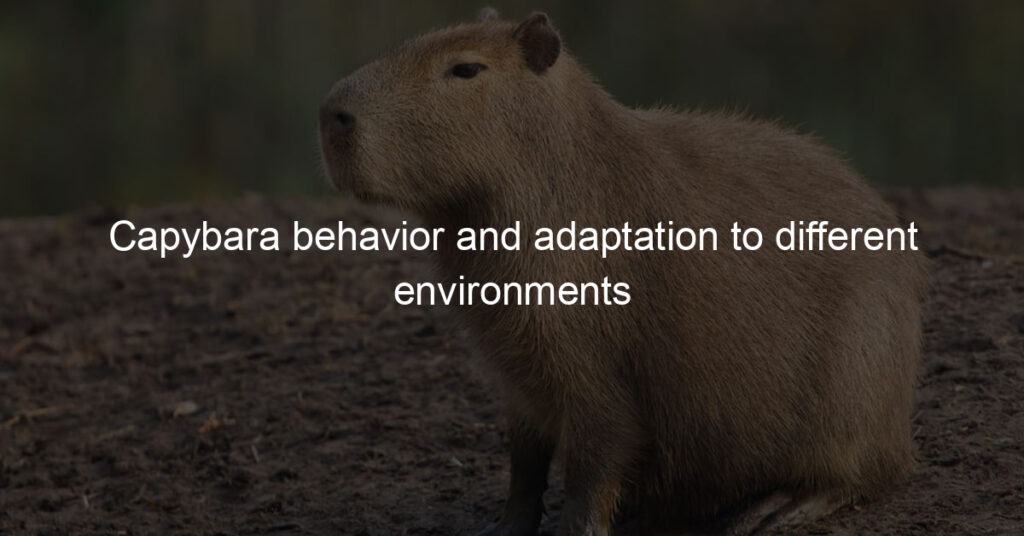Are you fascinated by the behavior and adaptations of capybaras? If so then you’ve come to the right place! You’ll love learning all about these amazing animals, their social behaviors, their diet, and how they thrive in different environments.
Capybaras are well known for being sociable with both humans and other animals alike; if given proper care this species can be a great choice as a pet. In this post, we’ll explore what makes them such special rodents and discover why so many people have grown to adore them.
What are capybaras’ behavioral adaptations?
Capybaras are one of the most interesting creatures in the animal kingdom because of their many behavioral adaptations. They use vocalization and scent marking to communicate with each other, which is a unique form of behavior for an animal so large and social to use.
Capybaras also have a high degree of curiosity which helps them find food sources, detect danger, and otherwise navigate their environment successfully. They are also known for forming strong family bonds, with males often looking after young capybaras, something quite rare among similar species. All these adaptions make capybaras both fascinating and successful animals!
What behaviors do capybaras have?
Capybaras definitely have some interesting behaviors! They’re quite social animals and live in groups that can range from a few to over 100 members. Being a PGroup-focused species, they will often groom each other, sleep cuddled up together, and even use communal latrines for toileting!
When it comes to food, capybaras are especially fond of aquatic vegetation and are known to spend hours a day grazing upon it. But they’ll also eat fruits, tree bark, and sometimes even small rodents if given the chance.
Interestingly enough – when playing with each other or other species like dogs – capybaras have even been known to make whistling noises as if they were communicating with one another! All of this goes to show that these semi-aquatic rodents have many fascinating behaviors.
What environment do capybaras like?
Capybaras are semi-aquatic rodents that love wet and aquatic environments. A good environment for capybaras to flourish consist of ponds, marshes, swamps, lakes, or rivers- anywhere with access to fresh water. Since they originated in South America, where there’s a ton of rainforest, they’re used to damp areas with plenty of trees, dense grass, and other vegetation nearby that they can snack on.
They have webbed feet which makes them excellent swimmers and are also great at finding spots within their habitats to hide away in kind of like nature’s game of hide and go seek. Capybaras form close bonds with one another and their worlds become when they’re living in groups!
What is the social behavior of capybaras?
When it comes to social behavior, capybaras communicate through vocalizations and scent markers—a trait that makes them quite the social butterflies. They can be found lounging around in groups of up to 100 individuals!
These semi-aquatic rodents form strong familial bonds too; a mother is known to stay close to her young for long periods. Capybaras are also quite docile and tend to live in peace with their surrounding neighbors unless they feel their sanctuary is being threatened of course. With some proper care and attention, these fuzzy creatures can make great furry friends inside or outside of the home!
What do capybaras do in the rainforest?
Capybaras are one of the most interesting creatures living in the rainforest! They spend their days exploring and swimming around, while they eat plants and fruits found there. The joys of being a capybara in the rainforest are that they can take in all the beauty it has to offer – lush green trees, vibrant multicolored birds, and perhaps even a sloth or two moseying around up above.
Capybaras are also social creatures by nature, forming enduring family ties with other capybaras that may last for generations. Being able to live among so many other amazing animals in such an unpredictable yet beautiful place must make life as a capybara especially rewarding.
What do capybaras need to survive?
For the most part, capybaras need the same basic things to survive as any other mammal: food, water, and shelter. They are herbivores so they need lots of green vegetation, such as hay and grasses high in cellulose. They also need fresh water to drink, stay hydrated, and keep their skin in good condition.
As for shelter, it can vary from a den built into the ground or a large outdoor cage with plenty of shade. Aside from these basics capybaras also benefit from having companionship – whether that’s another rodent or another species – to keep them stimulated. All in all, not too much is needed for these gentle giants to live happy, content lives!
Final Takeaways
From the savannas of South America to the rainforests of Central and South America, capybaras have adapted to a wide range of habitats. They can be found living in dense forests, scrublands, wetlands, rivers, and marshes. Their highly social behavior plays a significant role in helping them thrive across diverse landscapes and survive in changing environments.
While they are not typically aggressive towards humans, this semi-aquatic rodent still manages to remain relatively hidden despite its large size. With their unique personality and natural adaptations, capybaras prove that sometimes things are bigger than they appear – they’re far more than just giant rats! Thanks for learning about these amazing creatures with me today. Until next time!














